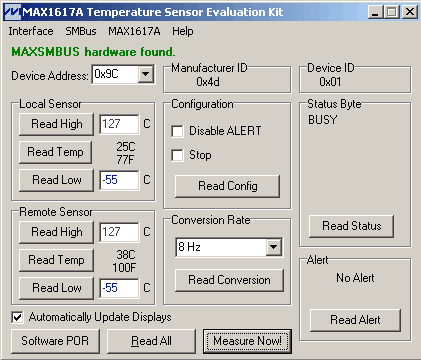Three Red-Hot Boxed Cooler Alternatives for the Athlon XP3200+
The Measurement Platform: Temperature Measurement Directly On The Die, Continued
This makes it possible to take precise measurements of thermal power during operation. It simply results from the product of the current drawn multiplied by the drop in voltage on the processor.

The user interface of the temperature sensor kit
We used an additional temperature sensor at a distance of about one inch above the ventilator fan in order to determine the ambient temperature. The processor (AMD Athlon XP-2400+) is then heated with the aid of a DOS program that guarantees a constant maximum processor utilization of one hundred percent. Instead of thermal pads, we used Arctic Alumina thermal paste in all of our tests.
From the thermal power readings of processor PV, die temperature TD and ambient temperature TA, and using the following formula Rtherm=(TD-TA)/PV in °C/W we calculate the thermal resistance Rtherm of the cooler/thermal compound combination. The lower this is, the better the cooler. The thermal resistance is also the decisive volume in the test. This is the measurement for the power of the cooler. For the sake of thoroughness, we will also give the maximum die temperature reached in the technical specifications table. However, this is only of limited use in comparing the power of individual coolers with one another.
Stay on the Cutting Edge
Join the experts who read Tom's Hardware for the inside track on enthusiast PC tech news — and have for over 25 years. We'll send breaking news and in-depth reviews of CPUs, GPUs, AI, maker hardware and more straight to your inbox.
Current page: The Measurement Platform: Temperature Measurement Directly On The Die, Continued
Prev Page The Measurement Platform: Temperature Measurement Directly On The Die Next Page AMD Boxed 3200+ CoolerMost Popular

